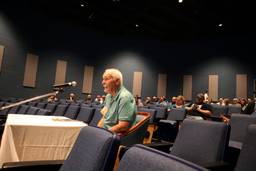My brother is a high school teacher. He is not famous, and certainly not rich. After he leaves this earth, autographed photos of him will not hang in bars or restaurants; there will be no beautifully lit, high contrast black-and-white posters of him á la James Dean.
But because so many of his students have recognized him as an exceptionally good teacher – a mentor who changed their lives – he will live on through them, in crucially long-lasting and embedded ways, for years to come. He’s not alone. That’s what it means to be a teacher, becoming entwined in others’ lives, and influencing their attitudes, behaviors, ideas and contributions to the world. It is a particular kind of immortality, yet one that we as a culture typically fail to appreciate and honor.
Of course there are bad teachers; we’ve all had them. When I was in high school, we had a guy who routinely came to work plastered, several who couldn’t teach at all, and a few who became – or tried to become – sexually involved with students. But the good ones were amazing, powerfully shaping our interests – what we decided to study in college, what we chose to do with our lives, how we made sense of the world.
So how are we treating our school teachers? In state after state, they have often been the first casualties of the Great Recession. While Snooki and her addled, perennially drunken co-stars on Jersey Shore enjoy their new pay raise, teachers in Georgia, North Carolina, California, Hawaii and elsewhere have been forced to take unpaid furlough days. All over the country, we’ve witnessed devastating teacher layoffs. It’s usually teachers – not administrators, not shrinking education budgets, not incompetent parents, not structural inequality – who are blamed when students bomb standardized tests or fail to graduate. Those who haven’t been fired are forced to teach to these mind-numbing fill-in-the-bubble tests, the results of which are then used against them if students don’t beat previous years’ scores.
Overall, this teacher-bashing has given excellent cover for decreased funding of K-12 education. This despite the fact that, nationally, about one-third of students still drop out of high school. In my own state, Michigan, only 38 percent of African-American and 44 percent of Hispanic students graduate from high school. According to one estimate, the dropouts from the class of 2008 will cost the state 12 billion dollars in lost wages over their lifetime, meaning less consumer spending, lower tax revenues and more social services.
Conservatives insist that there is no correlation between spending and educational outcomes, citing the relationship between increased expenditures on education in the 1980s and 1990s and minimal improvement in reading and math scores on the National Assessment of Educational Progress. Of course, if the wealthy and upper-middle classes in this country did not believe that spending more on teachers and facilities mattered, they wouldn’t send their kids to swanky private schools.
It is cliché to note that educating as many of our kids as possible is a crucial investment in the future – not just theirs but the country’s as a whole. Where we’re really failing is with poor and minority students; the NAACP recently described education in communities of color as in a “state of emergency.”
This is one reason why the Obama administration’s “Race to the Top” initiative (see cover story, page 16) has started to come under attack, as it continues to enshrine the standardized test (the bane of any good, creative teacher’s existence) – a test that narrows curriculum and is a stupid metric for assessing teacher performance. (New York state recently demonstrated how the results can be jiggered by simply lowering what once counted as “proficiency” in math or English.)
But back to the teachers. We delude ourselves that somehow celebrities are impervious to mortality because their films, music, or photographs live on after they die. Leaving a true mark, after you’re gone, is measured by the hearts, souls and psyches of people you’ve touched and changed for the better. We should be doing a much better job, as a culture, of acknowledging and rewarding that.

I hope you found this article important. Before you leave, I want to ask you to consider supporting our work with a donation. In These Times needs readers like you to help sustain our mission. We don’t depend on—or want—corporate advertising or deep-pocketed billionaires to fund our journalism. We’re supported by you, the reader, so we can focus on covering the issues that matter most to the progressive movement without fear or compromise.
Our work isn’t hidden behind a paywall because of people like you who support our journalism. We want to keep it that way. If you value the work we do and the movements we cover, please consider donating to In These Times.
Susan J. Douglas is a professor of communications at the University of Michigan and a senior editor at In These Times. She is the author of In Our Prime: How Older Women Are Reinventing the Road Ahead.








